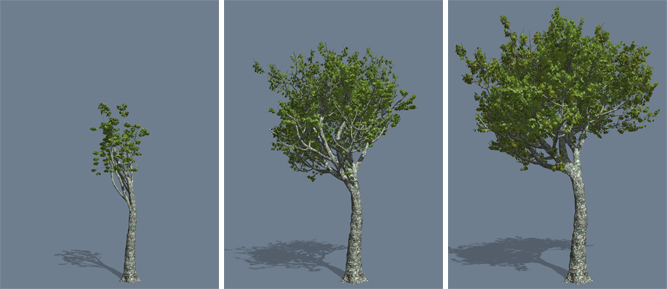Animated Growth
This section describes how to animate the growth of models created using spine and leaf generators.

Interface
The interface for growth is split between the ‘Timeline’ bar and the ‘Growth’ property groups on spine generators/nodes and leaf generators/nodes. The general procedure for making a model grow is as follows:
- Create the model as you would any other model. Leave growth disabled. This is the best time to take the limitations listed below into account. The best way to do that is to execute the 'Growth Wizard' on the model at this stage.
- Enable ‘Growth’ on the ‘Timeline’ bar. Use the timing controls/slider to preview the animation.
- Tune the behavior by editing the properties in each generator’s ‘Growth’ group.
You’ll notice that as the tree becomes fuller the preview becomes much slower due to the longer compute times. You can speed this up either by hiding/unlinking generators or using the new ‘Focus’ feature. Click the 'Focus:Target' button on the toolbar and then click a branch on the tree model. All subsequent computes (including growth) will be limited to the selected node and its children until the 'Focus:Clear' button is pressed. This is often the best way to get an interactive preview of the growth process.
Another way to see a quick preview of the growth animation is to use the 'Export image sequence' option in the 'File' menu to create a sequence of images rendered from the Modeler.
Timeline Bar
The ‘Timeline’ bar (pictured below and accessed via Window→Timeline from the main menu) is where growth is enabled/disabled. The 'Speed' edit box sets the baseline speed at the model grows. Vary this value to make the entire model grow slower or faster. Each generator has its own speed scale properties that modify this value if you need to control the growth rate of individual parts of the model.
The ‘End’ frame here simply sets the end of the preview. The actual end of the growth animation is determined by the 'Speed' value you enter and the speed scale properties on the generators.
Properties
Spine generators/nodes and leaf generators/nodes have a property group labelled 'Growth'. Edit the properties in these groups to achieve the desired animation.
Growth Wizard, Modifications, and Limitations
We’ve made several modifications to the tree algorithm in order to eliminate undesirable artifacts (most noticeably segmentation changes). In addition, we’ve identified some limitations in the form of properties that can’t always be used without negative consequences to the growth animation.
Use the ‘Growth Wizard’ button on the 'Timeline Bar' to automatically address the issues covered in this topic.
Modifications
The modifications presented here represent slight changes to the tree generation algorithm and shouldn’t present any major issues.
- Welding: A new welding style labeled 'Growth friendly' has been added to Spine generators/nodes. This style replaces the original welding algorithm and facilitates growth by reducing segment popping.
- Sky Sensitive Leaf Orientation: This leaf orientation style has been modified slightly to allow for more noticeable animation when using the Growth:Start Scalars:Orientation property.
Limitations
The limitations presented here are the primary target for the ‘Growth Wizard’ and represent the biggest challenge in creating a smooth animation.
- Bifurcation: The current bifurcation scheme does not work at all with growth. The primary culprit is the discrete saddle piece that binds the three parts of bifurcated branches. It is either there or not, resulting in noticeable pops.
- Spine:Alignment: Non-zero values for this property may result in sudden orientation shifts during the growth process. Setting this value to 0.0 with no variance eliminates these issues. Alternatively, you can node edit the position, rotation, or alignment of offending branches to eliminate the problem.
- Generation:Alignment: Similar to Spines, it may be necessary to disable alignment to eliminate orientation shifts.
- Jaggedness: This value must be 0.0 in the current system. This has little to no effect on most models.
- Level of Detail The properties in this group still affect the highest LOD (e.g., the main model). ‘Branch volume threshold’ can lead to branches popping in and out so its value should be set to 1.0 with a ‘max’ parent curve.
- Segments: Optimization should be set to 0.0 and the radial segment profile curve should be set to ‘max’ to avoid segment popping (particularly on welds).
- Radius Style: This property should be set to ‘relative’ so that the radius grows properly with its parent.
Exporting
Select 'File→Export Growth Sequence…' to export the growth animation as an Alembic file (this is currently the only option for growth animation exporting).
